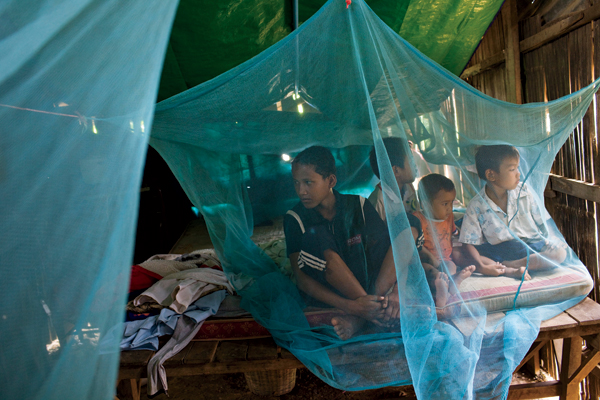Matthew Power is a contributing editor of Harper’s Magazine. His article “Slipping Through the Net: Cambodia’s border war against drug-resistant malaria” appears in the April 2012 issue.

Photograph by Aaron Huey
In October 2007, Bill and Melinda Gates—benefactors of the largest private foundation in the world—stood before a packed audience of public-health experts and government officials in Seattle and announced their intention to free the world of malaria, a disease that has haunted all of human history. It was an audacious objective—one that met with public praise and private skepticism from malariologists who had spent their careers in an often-losing battle.
The Gateses—and $1.75 billion of their money—have been at the vanguard of a newly energized campaign against the mosquito-borne parasites that cause malaria. Remarkable progress has been made in the past decade: in 2000, the World Health Organization estimated that 3,000 people were dying daily from the disease; today, that number is down to 2,000. One of the key pillars of the fight is a multidrug treatment that includes artemisinin, a potent antimalarial derived from sweet wormwood. As such older malaria drugs as chloroquine and pyremethamine have gradually lost their efficacy, malaria-control programs around the world have rolled out an artemisinin-based combination therapy as the frontline treatment. Hailed initially as a magic bullet, the drug has by some estimates saved more than a million people—most of them children in sub-Saharan Africa. Currently, no other drugs exist to replace artemisinin in the public-health arsenal.
As I reported in the April issue of Harper’s Magazine, in 2008 researchers announced that artemisinin resistance was beginning to appear among malaria patients in a remote area of western Cambodia, along the border with Thailand. The possible causes were manifold: the spread of counterfeit antimalarials, inadequate dosages for genuine ones, and a highly mobile and inaccessible population. Fearing disastrous consequences, the Gates Foundation disbursed $22 million for an ambitious program, spearheaded by the WHO, to try and contain the spread of artemisinin resistance.
Now, three years after that containment effort began, and just as some signs of success have been reported, a new study has been published showing that the problem may be far more widespread than previously suspected. The article, published this month in The Lancet, examines the malaria-parasite clearance rates of 3,202 patients treated with artemisinin from 2001 to 2010 along the border of Thailand and Burma, hundreds of miles from the Thai–Cambodian border region where resistance was first observed. While the drug was still able to halt malaria, researchers noted a disturbing trend: cases with a slow clearance rate (a sign that drug efficacy is weakening) increased from 0.6 percent in 2001 to 20 percent in 2010. In other words, drug-resistant malaria had already begun to spread out of the containment zone before researchers were aware of its existence. In as few as two years, the researchers found, resistance rates along the Thailand–Burma border could be as high as the ones Gates and the WHO have spent millions trying to contain in Cambodia. The fate of artemisinin—and the global fight against malaria along with it—is now more tenuous than ever, and the net to contain resistance must be cast farther afield.
These new findings are especially unwelcome because of their location. Cambodia, for all its structural and economic problems (partly a legacy of its civil war), has a very engaged and committed public-health sector, aided by the presence of numerous NGOs. Burma, by contrast, has a poorly funded public-health infrastructure and hosts far fewer international health monitors, an unfortunate consequence of its ostracism by foreign governments during decades of military rule. It also has by far the highest disease burden in Southeast Asia, with nearly half a million malaria cases annually. Furthermore, Burma borders India, which has 1.6 million cases annually; from there, researchers fear, a domino effect of drug-resistance could begin, ultimately reaching the vast parasite pool of Africa, where 90 percent of the world’s malaria cases occur.
The recent parliamentary byelections in Burma, and particularly the landslide victory of former political prisoner Aung San Suu Kyi, have inspired hope for political change there for the first time in decades. The country faces an epic challenge in rebuilding its civil-society institutions, and it is still early to celebrate the junta’s obsolescence. Malaria is not likely atop the priority list. Burma didn’t ask to find itself on the front line of the war against malaria, but if artemisinin and the global health infrastructure that depends on it are to be saved, that is where the fight must now turn.


